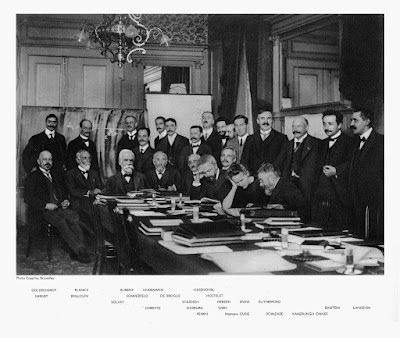kw: book reviews, nonfiction, biographies, physics, relativity, quantum theory
In his famous 1926 protest, Albert Einstein wrote,
"Quantum mechanics is certianly imposing. But an inner voice tells me that it is not yet the real thing. The theory says a lot, but it does not really bring us any closer to the secrets of the "Old One." I, at any rate, am convinced that He is not playing dice."From this comes the title of a valuable, but flawed, book.
Reading Secrets of the Old One: Einstein, 1905 by Jeremy Bernstein was frustrating. I have a pretty good understanding of special relativity (very little, thought, of general relativity, but it wasn't in view here), the photoelectric effect, and statsitical mechanics. The author attempts to make the almost unbelievable work that Albert Einstein did in 1905 accessible to a lay audience. I don't find it illuminating.
 The value that Dr. Bernstein brings to this mini-biography—of the 1905 work, not so much the man—is his direct connection to the people involved, his review of the discoveries that did and didn't influence Einstein, and the milieu in which Einstein's work was received. The illustration shows many of those whose work I remember studying decades ago.
The value that Dr. Bernstein brings to this mini-biography—of the 1905 work, not so much the man—is his direct connection to the people involved, his review of the discoveries that did and didn't influence Einstein, and the milieu in which Einstein's work was received. The illustration shows many of those whose work I remember studying decades ago.
After a chapter outlining the history of physics, particularly electrodynamics and mechanics, the three articles Einstein submitted in mid-1905 are discussed, first the paper on Special Relativity (the third in order submitted) plus a small fourth paper that first elucidates E = mc2; second the paper on Brownian Movement, in which he demonstrated the appropriate statistics to show that atomic rather than continuous matter best explained the phenomenon; and third the paper on Blackbody Radiation and the Photoelectric Effect, which won him the 1921 Nobel prize.
A minor frustration with the book is that it was poorly proofread. Both Bernstein and his editor (was there one?) seem to think that the past and past participle of "lead" is "lead", rather than "led". This mistake is quite consistent. Comma misuse and sentence fragmentation is rampant. I corrected very few items; in most books I read, I correct all; the volume was too distracting.
The major frustration is a great tendency to assert results with little or no justification. For example, in several pages of explanation of the simultaneity versus non-simultaneity experienced between to systems in relative motion, the reasons for the difference in perception are only sketchily described, where a simple statement that, for example, "For the signals from two events to be perceived as simultaneous in System 2, they would have had to occur at equal distances from the receiver. The geometry as seen from System 1 shows that they occur at different distances." Throughout that chapter, the rotation of axes that causes geometry and time to influence one another is poorly explained.
Thus, whereas I began hoping to learn more of Einstein's thought, I instead learned more of his social circle, which is not in itself a bad thing.



No comments:
Post a Comment